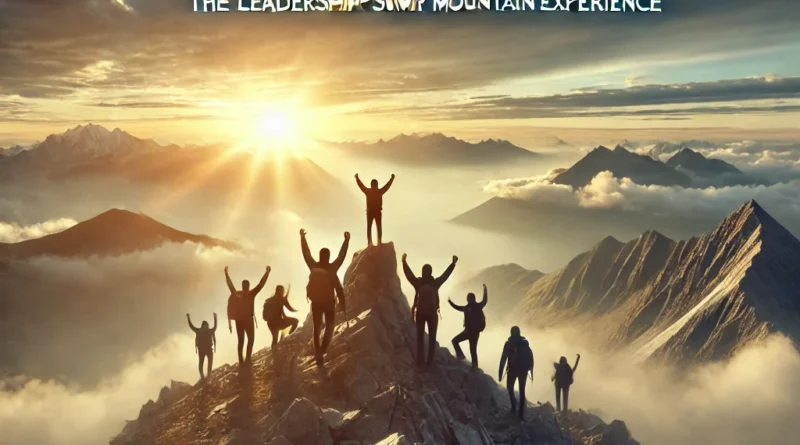Climbing New Heights: The Leadership Summit Mountain Experience
Scaling New Heights: Leadership Summit Mountain Experience
Imagine an off-site leadership that defies all limits. How about one that offers the excitement of mountain climbing and the sensitive aspect of self-development? We would like to present to you the leadership summit mountain experience. It’s a perfect amalgamation between professional learning and recreational activities.
This article will detail how retreat innovation can transform your staff retreat agenda. Get ready to scale new heights of leadership.
Introduction
Setting the stage for The Leadership Summit Mountain Experience
A leadership mountain summit retreat opened up previously untapped opportunities. Participants undergo both physical and psychological exercises, all while being in a beautiful green setting. This summit incorporates luxurious sights with leadership skill training. The summit is more than just a break from the daily routine—it is a lifestyle. This is the goal of the summit experience—to harness a new sense of self-achievement.
The summit agenda included a mix of workshops and outdoor excursions, which encompassed deeper discussions. These participants can stimulate creativity while also reinforcing group synergy. The overall experience of a summit promotes self-development and personal achievement.
The Importance of Leadership Retreats
This is why leadership retreats are instrumental to an organization that wishes to progress. The focused elbow room enables breaking and building ideas as well as thoughts. These retreats allow them to untangle with all the monotonous distractions while making learning deep and meaningful.
Motivation is something a team always needs; that is why they use a well-crafted staff retreat agenda for the retreat they are going on. Team members can communicate and collaborate more effectively. Retreats also provide an opportunity to face organizational issues in a more encouraging environment. Such experiences have their benefits well beyond the retreat and have a positive effect on daily work.
The Journey Begins: Preparing for the Summit
Setting goals for personal and professional growth.
Before planning a leadership mountain summit retreat, go for an adjustment test; it is important to set specific goals. What do you intend to accomplish on a personal and professional level? These goals determine what benefit you will get from the retreat and how you could structure your experience. Some goals to consider would be improving leadership techniques and building team spirit. By setting these goals, you ensure that there is a particular intention for the summit journey and that it is fulfilling.
Packing Essentials for the Leadership Retreat
Retreat preparations include much more than setting goals. You must also pack the right necessities for a smooth experience.
Pack sturdy outdoor equipment for use in the mountains. Warm clothes, hiking shoes, and a backpack are a given. Also, take a journal to record retreat learnings for later contemplation.
Apart from outdoor equipment, think about utility items. These comprise a water bottle and energy bars for maintaining energy levels. There is also an emergency first-aid kit, which is useful in an emergency. With excellent preparation, you tend to concentrate on the growth journey that is before you.
The mountains have their own retreat navigation.
Adjustability and willingness to embrace are crucial in using particular mountain retreats. The leadership summit begins with the activities schedule, interspersed with breaks for individual exploration. We assign specific tasks to participants, ensuring they push their boundaries and foster breakthroughs in leadership.
The agenda includes trust exercises and discussions at the strategy level. We devise each component to stimulate innovative approaches and cooperation. Consider every challenge an opportunity to tackle problems for self-profit development. Mountains have a way of appearing detached, which provides an opportunity to deeply contemplate and develop.
New Peaks: Workshops and Other Activities
Team-Building Exercises in the Mountains
At the heart of any mountain retreat are team-building exercises enhanced by nature-based challenges. Teams are involved in ice climbing, hiking, and even ground trust falls. Such exercises require collective efforts and ingenious tactics. These exercises strengthen social collaboration through trust. The people relied on each other as they learned effective communication skills. These approaches lead to effective teamwork upon returning.
The focus of workshops on leadership and innovation
Every retreat has a central theme: leadership workshops. Facilitators guide the participants through sessions focused on future planning and advanced concepts. Other topics include agile and creative leadership. The intention of those workshops is to develop a will to solve problems differently. The workshops teach participants how to improve the organizational culture. The priority is to perfect the techniques that facilitate growth and development.
Interactive Leadership Problems and Problem Solving
These sessions serve to promote collaboration and enable participants to attend to the more pressing issues in leadership. Participants work together to come up with solutions for problems that are not so easy to solve. Such problems include crisis management or how to allocate scarce resources. These exercises are beneficial as they enhance one’s capacity to think and adapt. This series of sessions enhances the leader’s ability to think creatively and adapt to any situation. The ever-changing business environment necessitates the use of such techniques and skills.
Contemplations and Resources: The Mountain Spirit to Embrace
Ways This Relates to Leadership: Strategies to Protect the Environment
During a mountain retreat, the role of nature is crucial when it comes to developing a leader. The tranquil environment is suitable for self-analysis, which leads to enhanced imagination. Thinkers can reflect with a stunning sight and clean air without disturbances. In this way, leaders are more likely to develop innovative ideas. Nature acts as a filter. It helps clear the distractions and multiplies mental strength. Consequently, it serves as a source of inspiration.
Evening reflections and networking opportunities
Evenings at the summit are brimming with possibilities for social connections and contemplation. Group dinners and campfires are perfect settings for informal sharing. Participants strengthen relationships through conversations about dreams, experiences, and insights. Relaxed settings encourage the free exchange of ideas and build respect among colleagues. Such interactions serve networking purposes, paving the way for collaborations at a later stage. Engagements like these are important for knowledge sharing and establishing professional relationships.
Personal growth through mindfulness and meditation.
Mindfulness and meditation are crucial highlights of the retreat. Its value increases when one practices it within a peaceful environment of mountains. These activities assist participants in stress management and focus. Consistent practice of mindfulness builds self-awareness along with emotional intelligence. Leaders recharge themselves through inner calmness fostered by meditation. They come back ready to tackle problems with greater mental clarity.
Conclusion
Ultimately, I would like to point out the main ideas discussed above regarding the leadership summit mountain experience.
With the leadership summit mountain experience, growth and learning are effortless and overwhelming. Merging leadership training with a thrilling experience promotes creativity and collaboration. Participants gain a renewed sense of purpose and fresh insights. The unique environment of the retreat fosters resilience as well as collaboration among the attendees and speakers.
Setting goals for leadership retreat planning.
The use of mountain scenery for a leadership retreat can have unmatched benefits. Set boundaries and keep a diversity of activities in mind. Adjust the schedule of the staff retreat to cater to the team’s needs. Focus on the safety as well as the inclusivity components of the experience so it can be rewarding.




